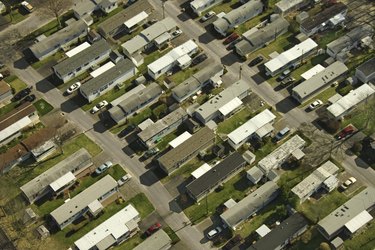Things You'll Need
Laser tripod
Shovel
Galvanized steel helical screws
Galvanized steel shaft sections
Integral connectors
Galvanized L-shaped pier brackets
Bolts
Chipping hammer
Hydraulic jack
Hydraulic rotary drive motor

Unless you live in a motor home, nothing is worse than discovering the place you call home is moving. Your house could be built on a hill or atop unstable soil. If your home is settling because of these factors, foundation repairs are almost always necessary. The good news is the problem of home settlement can be fixed through the installation of helical piers. The bad news, depending on how badly your home is sinking, is that repairs can be time-consuming, cost tens of thousands of dollars and require the expertise of a foundation-repair specialist.
Installing Helical Piers
Step 1
Set up a laser tripod along the home's exterior wall where settling has occurred. Activate the laser. Measure the depth of settlement by running the laser horizontally along a mortar line.
Video of the Day
Step 2
At least two business days before doing any digging, contact your local utility and cable companies to discover if there are any underground lines near the home's foundation.
Step 3
Place holes 5 to 6 feet apart adjacent to the home's exterior wall where settlement has occurred. With a shovel, dig the holes to the depth of the home's footing in a 3 feet by 3 feet excavation, leaving the displaced dirt adjacent to the holes.
Step 4
Position a galvanized steel helical screw in each hole within two inches of the home's foundation. Use a hydraulic rotary drive motor to rotate the helical screw into the ground. Attach a galvanized steel shaft section to the helical screw with integral connectors. Attach additional steel shaft sections to one another as necessary until the entire helical pier reaches suitable bearing depth, which averages less than 40 feet into the ground.
Step 5
Use a chipping hammer to mold the bottom and face of the footing into a right-angle corner. Seat the galvanized L-shaped pier bracket beneath the foundation wall. Attach a galvanized L-shaped bracket to the helical pier and attach a bracket to the foundation wall, transferring the home's load from the foundation to the helical pier.
Step 6
Lift the settled area of the home by attaching hydraulic jacks to each galvanized L-shaped bracket that has been placed. Some lift may be possible to restore the structure to its original position. But stop lifting at any sign of cracking or other damage to the home.
Step 7
Cover each helical pier with displaced dirt and give the surface dirt several months to settle before reseeding with grass or other ground cover.
Tip
Leave yourself at least a week to prepare and complete foundation work of this magnitude. It is a good idea to first consult with an engineer to properly assess the root cause of a home's settlement and perhaps involve a foundation specialist to properly designate where helical piers should be situated. If you decide to contract this work to a foundation specialist, be prepared to pay between $1,500 and $2,000 per helical pier, depending on the fluctuating price of steel.
Warning
When digging, be careful not to come into contact with any underground power, water, cable television or natural gas lines that may be located near a home's foundation.
Video of the Day